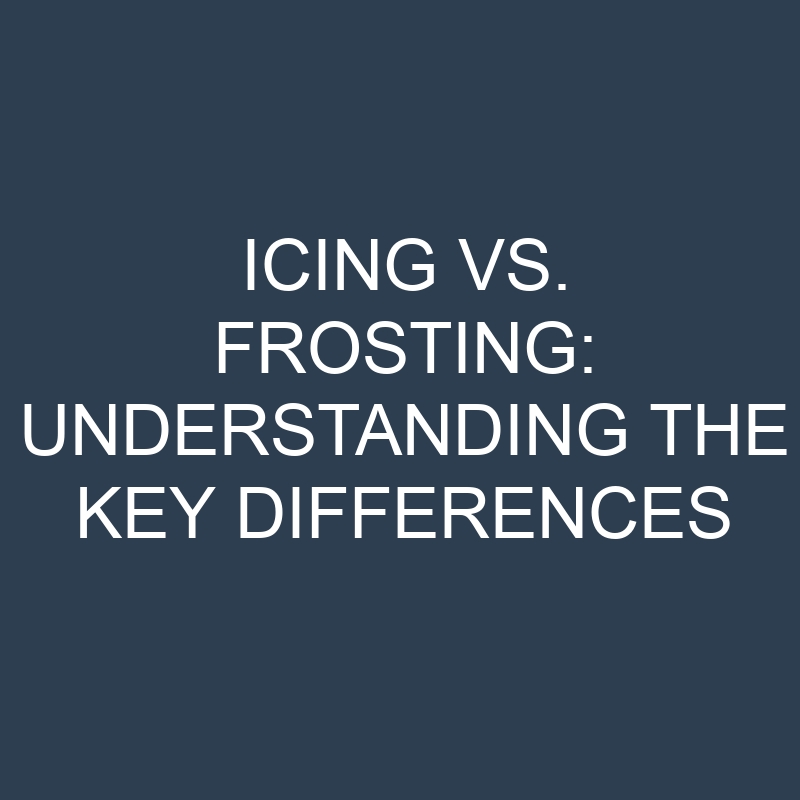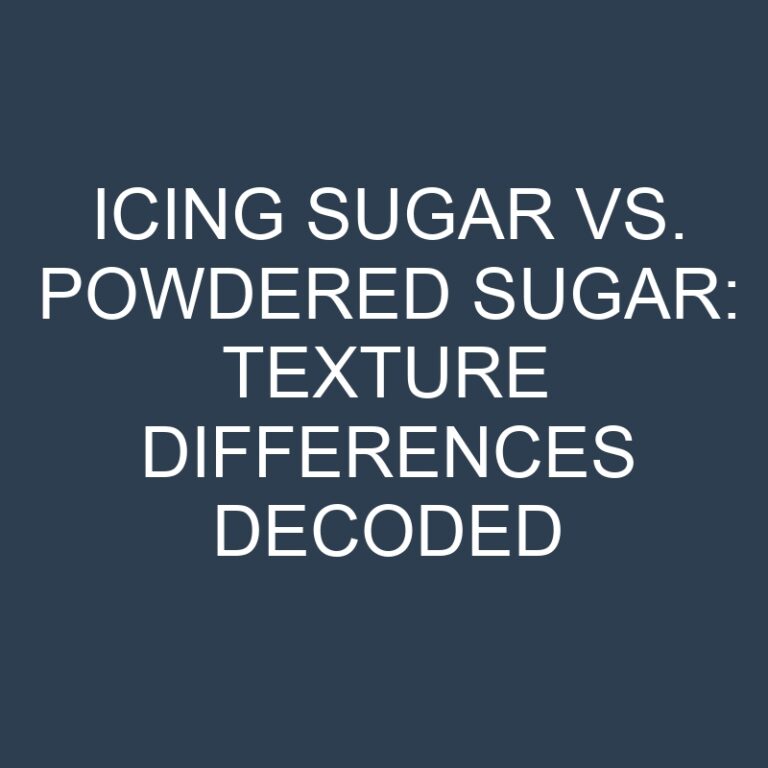
Have you ever wondered what sets icing apart from frosting? As a baking enthusiast, I’ve often found myself pondering this sweet conundrum. In this article, I’ll delve into the nuances that differentiate these two delectable toppings.
Let’s start by unraveling the mystery of icing versus frosting. Understanding the disparities between these sugary finishes can elevate your baking game to a whole new level. Join me as we explore the distinct characteristics that make icing and frosting unique.
Post Contents
Key Takeaways
- Icing vs. Frosting: Icing is thinner, glossier, and ideal for decorating cookies, while frosting is thicker, creamier, and best for layering cakes or cupcakes.
- Ingredients in Icing: Simple ingredients like confectioners’ sugar, vanilla extract, milk or cream, and butter are key to creating smooth and flavorful icing for baked goods.
- Ingredients in Frosting: Frosting typically includes powdered sugar, butter, milk or cream, and vanilla extract, resulting in a rich and creamy texture that enhances the taste of desserts.
- Texture Differences: Frosting is thick and creamy, suitable for spreading, while icing is thin and sets firm, perfect for intricate designs and decorations.
- Best Uses: Icing is great for decorating cookies with intricate designs, while frosting is ideal for spreading on cakes, thanks to its creamy texture and richness from butter.
Definition of Icing and Frosting
When it comes to baking terminologies, understanding the difference between icing and frosting is crucial. Icing is typically thinner, glossier, and sets firm, making it ideal for decorating cakes and cookies. On the other hand, frosting is thicker, creamier, and fluffier, often used for layering cakes or cupcakes.
In essence, icing is a thinner and more liquid sugar-based coating, while frosting is a thicker and denser butter or cream-based mixture. The distinct textures of these sweet toppings can significantly impact the overall taste and presentation of your baked goods.
While icing is perfect for creating intricate designs and details due to its smooth consistency, frosting is favored for its ability to hold its shape for elaborate decorations and piping. Each variant plays a unique role in elevating the visual appeal and flavor profile of your confections.
Ingredients Used in Icing
When it comes to icing, simplicity is key. I usually use just a few basic ingredients to whip up a delicious icing for my baked goods. Here are the key components I rely on:
- Confectioners’ sugar: Also known as powdered sugar, this finely ground sugar is a must-have for creating a smooth texture in my icing.
- Vanilla extract: Adding a touch of vanilla extract enhances the flavor profile of the icing and gives it a delectable aroma.
- Milk or cream: To achieve the perfect consistency, I often use a small amount of milk or cream to thin out the icing as needed.
- Butter: Incorporating butter adds richness and a luscious mouthfeel to the icing, elevating its taste.
By combining these simple yet essential ingredients, I can effortlessly create a velvety-smooth icing that not only tastes heavenly but also enhances the overall appeal of my baked treats.
Ingredients Used in Frosting
When it comes to frosting, the ingredients may vary slightly from icing. I prefer using powdered sugar for its fine texture, butter for richness, milk or cream for consistency, and vanilla extract for that extra flavor boost. By carefully balancing these components, I always achieve a smooth and creamy frosting that complements my baked treats perfectly.
In my experience, the richness of butter in frosting adds a decadent touch, while the powdered sugar ensures a silky-smooth consistency. A dash of vanilla extract enhances the overall flavor profile, making the frosting taste irresistible. Lastly, adjusting the milk or cream content helps me achieve the ideal thickness for spreading or piping the frosting onto my cakes or cookies.
By mastering the art of combining these key ingredients in precise proportions, I consistently produce delicious frostings that not only taste heavenly but also elevate the visual appeal of my baked creations. Experimenting with different ingredient ratios can lead to unique variations in texture and flavor, allowing for endless creativity in the world of baking.
Remember, when it comes to frosting, precision and quality ingredients are key. With the right balance of powdered sugar, butter, milk or cream, and vanilla extract, you can create luscious frostings that will impress any palate.
Texture and Consistency Differences
When it comes to texture and consistency, the variance between icing and frosting is crucial to understand for perfecting your baked creations.
- Frosting tends to be thicker and creamier, ideal for spreading smoothly over cakes and cupcakes.
- Icing, on the other hand, is thinner and sets firmer, making it excellent for decorating cookies or creating intricate designs on pastries.
The butter content in frosting contributes to its richness and creaminess, providing a smooth and luxurious texture that melts in your mouth. Powdered sugar plays a key role in frosting’s consistency, allowing it to hold its shape while retaining a softness that complements baked goods perfectly.
In comparison, icing typically contains water or milk as a base, giving it a thinner consistency that hardens when dried. This makes icing a preferred choice for intricate piping work where maintaining precise shapes and designs is essential.
By understanding these differences in texture and consistency, you can choose the right option for your baking needs and create stunning desserts that not only taste amazing but also look visually appealing.
Best Uses for Icing and Frosting
When it comes to icing, its thin consistency makes it perfect for decorating cookies. The fact that it contains water or milk also allows it to set firm when dried. This characteristic is what makes it ideal for intricate designs on baked goods.
On the other hand, frosting is known for its thickness and creaminess, making it a great choice for spreading on cakes. The richness of frosting comes from its butter content, giving it a creamy texture that enhances the overall taste of the dessert.
Whether you’re looking to add a decorative touch to your cookies with intricate designs or to create a smooth and creamy layer on top of a cake, understanding the best uses for both icing and frosting is essential for achieving visually appealing and delicious desserts.
Conclusion
Knowing the differences between icing and frosting is key to elevating your dessert game. Icing’s thin consistency and ability to dry firm make it perfect for intricate cookie designs, while frosting’s creamy texture from butter is ideal for enhancing cake flavors. Whether you’re decorating cookies or layering cakes, understanding when to use icing versus frosting will take your creations to the next level. Experiment with both to find the perfect balance of taste and aesthetics in your baked goods. Mastering these distinctions will make you a pro in the world of sweet treats.
Frequently Asked Questions
What is the difference between icing and frosting?
Icing is thin with water/milk, great for intricate designs on cookies. Frosting is thick and creamy, perfect for spreading on cakes.
How does icing differ from frosting in terms of consistency and texture?
Icing has a thin consistency and dries firm, ideal for detailed designs. Frosting is thick and creamy, enhancing the taste of cakes.
Why is it important to understand the differences between icing and frosting?
Understanding the variations helps in choosing the right one for specific dessert applications, whether for decorations or taste enhancement.
What are the best uses for icing and frosting in dessert making?
Use icing for intricate cookie decorations and frosting for spreading on cakes to elevate their taste and visual appeal.






